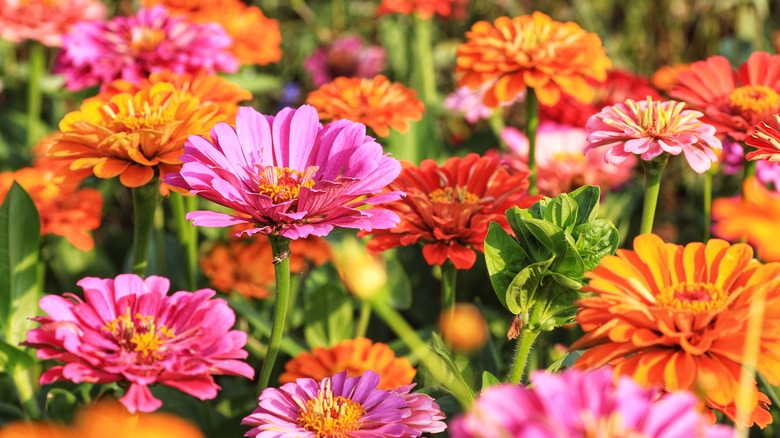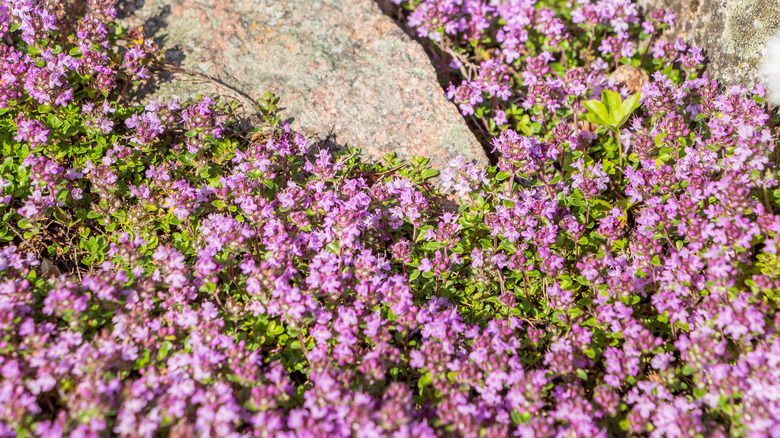The Low-Growing Perennial Herb That Blocks Out Weeds Around Zinnias
Zinnias are like the shazam flowers of summertime, as growing and caring for them is pretty simple. Sprinkle the seeds where you'd like them to grow, give them a good watering for a couple of days, and shazam, these zesty flowers shoot up quickly to catch every ounce of sunlight and heat they can get. Zinnias are a flowering hummingbird favorite that can be grown from seed and are best suited for USDA zones 3 through 10. Because they can spring up to heights of 4 feet, the ground around them may get a little unkempt as competitive weeds attempt to grow in the spaces underneath the blooms' tall heads. If this has ever been an issue for you, a great companion plant to grow under your zinnias to block out those weeds is creeping thyme.
Creeping thyme (Thymus praecox) is a mediterranean ground cover perennial that grows best in the dry soil of USDA zones 4 through 9. Besides suppressing weeds, it also attracts bees and butterflies, which enhances zinnia pollination. There are around 350 different species of thyme that belong to the mint family. Unlike common thyme, creeping thyme is not known for its flavor-enhancing qualities in cooking. Instead, it's known for its benefits when gardening and landscaping.
Weed-suppressing creeping thyme
Creeping thyme makes a wonderful addition to the spaces around zinnia beds, as well as on the edges of garden boxes, borders, and rocks. It can also be used to fill in areas of bare ground. The plant has fuzzy leaves and only grows to be 3 to 6 inches high, focusing its energy along the ground. Herbs like creeping thyme make great drought-resistant grass alternatives for your yard. Creeping thyme works great with zinnias because they both get excited over full sunlight and prefer well-draining soil. Zinnias are taller and creeping thyme likes to lay low. It can get messy if both companion plants are similar heights as they would have to compete for space, so choosing these two plants helps you avoid those issues.
One of the best benefits of planting creeping thyme alongside zinnias is that as the ground cover grows, it creates a low matted network that blocks weeds from being able to grow. Thyme acts as a natural blanket around the flowers. Furthermore, if left alone, weeds can bring diseases and pests that can stifle the zinnias' growth or even kill them. By simply growing this easy-to-care-for herb, you'll effectively keep pesky weeds at bay, leading to a thriving flower garden.
How to plant zinnias and creeping thyme together
To successfully grow creeping thyme, start it from seed indoors eight weeks before the last frost, then transplant the seedlings into the garden in late spring, placing them 10 to 12 inches apart. Because the perennial creeping thyme takes about a year to establish and start to spread, you may want to plant this herb one year before growing your annual zinnias. Keep in mind that in the first year, thyme needs to stay moist to build a strong root system. It can be watered as often as every day if the temperature is extremely hot. Once the thyme has been established, you can add the zinnias in the spring after any chance of frost has passed.
It is important, however, not to overwater both of these plants, as too much moisture can cause fungal diseases like root rot for thyme and powdery mildew for zinnias. They both prefer being dry over soggy. Establishing creeping thyme eliminates watering worries because the thick tangle becomes a layer of protection that helps the ground retain moisture and stay cooler in the heat of summer. Imagine a garden that works for you. With creeping thyme doing the weed elimination around your zinnias, there's less weeding to do, giving you more time to enjoy your healthy flowers.


